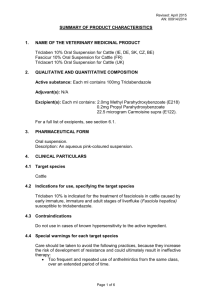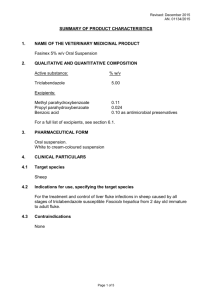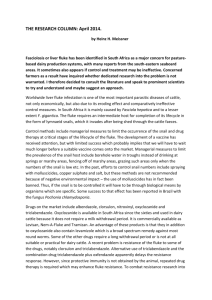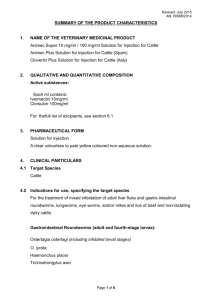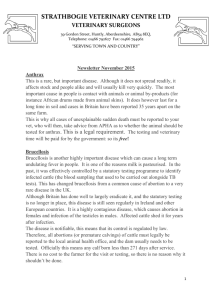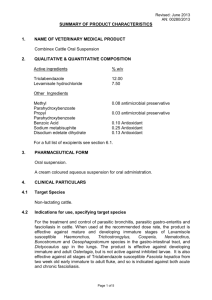Revised: April 2015 AN: 00912/2014 SUMMARY OF PRODUCT
advertisement
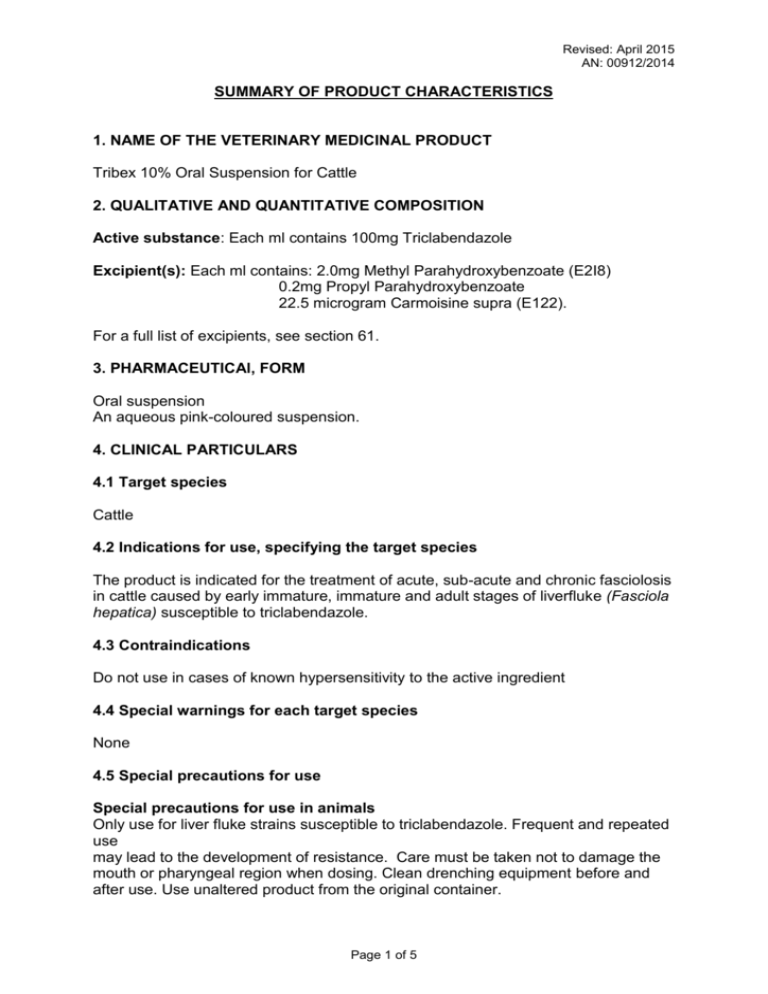
Revised: April 2015 AN: 00912/2014 SUMMARY OF PRODUCT CHARACTERISTICS 1. NAME OF THE VETERINARY MEDICINAL PRODUCT Tribex 10% Oral Suspension for Cattle 2. QUALITATIVE AND QUANTITATIVE COMPOSITION Active substance: Each ml contains 100mg Triclabendazole Excipient(s): Each ml contains: 2.0mg Methyl Parahydroxybenzoate (E2I8) 0.2mg Propyl Parahydroxybenzoate 22.5 microgram Carmoisine supra (E122). For a full list of excipients, see section 61. 3. PHARMACEUTICAl, FORM Oral suspension An aqueous pink-coloured suspension. 4. CLINICAL PARTICULARS 4.1 Target species Cattle 4.2 Indications for use, specifying the target species The product is indicated for the treatment of acute, sub-acute and chronic fasciolosis in cattle caused by early immature, immature and adult stages of liverfluke (Fasciola hepatica) susceptible to triclabendazole. 4.3 Contraindications Do not use in cases of known hypersensitivity to the active ingredient 4.4 Special warnings for each target species None 4.5 Special precautions for use Special precautions for use in animals Only use for liver fluke strains susceptible to triclabendazole. Frequent and repeated use may lead to the development of resistance. Care must be taken not to damage the mouth or pharyngeal region when dosing. Clean drenching equipment before and after use. Use unaltered product from the original container. Page 1 of 5 Revised: April 2015 AN: 00912/2014 Special precautions to be taken by the person administering the veterinary medicinal product to animals When using the product do not eat, drink or smoke, Wear gloves. Wash splashes from eyes and skin immediately. Take off any contaminated clothing immediately. Wash hands and exposed skin before meals and after work. In cases of hypersensitivity and contact allergy, direct skin contact and inhalation should be avoided. 4.6 Adverse reactions (frequency and seriousness) None known 4.7 Use during pregnancy, lactation or lay The product can be safely given to pregnant cattle. 4.8 Interaction with other medicinal products and other forms of interaction None known. 4.9 Amounts to be administered and administration route For oral administration only, using properly calibrated dosing equipment. Estimate bodyweight accurately. Shake container before use. Recommended dose rate: 12 mg triclabendazole per kg bodyweight as a single administration. DOSAGE GUIDE: Bodyweight Dosage Bodyweight Dosage Up to 50 kg 100 kg 150 kg 200 kg 6 ml 12 ml 18 ml 24 ml 250 kg 300 kg 350 kg 400 kg 30 ml 36 ml 42 ml 48 ml For animals over 400 kg - give an additional 6 ml for each additional 50 kg bodyweight DOSING PROGRAMME: Routine treatment (Areas of heavy fluke infection) As a guide, dose all cattle exposed to fluke infected pastures preventatively at regular intervals of 10 weeks from March/April through to October/November. In situations where stock are out-wintered, another dose in January may be required. All animals grazing the pasture should be treated at these times. All bought in animals should be dosed before joining the main flock. Veterinary advice should be sought with regard to specific preventative dosing regimes. Page 2 of 5 Revised: April 2015 AN: 00912/2014 Routine treatment (Areas of moderate fluke infection) Dose all cattle on fluke infected pastures at intervals of 10 weeks throughout the fluke season, usually September to January/ February. An additional preventative treatment in the spring will assist in reducing the amount of new infestation on the pastures in the following autumn. All bought in animals should be dosed before joining the main herd. In-wintered cattle Where cattle are in-wintered, a single dose of the product should be given 2 weeks after housing. Treatment of sub-acute and acute outbreaks Affected cattle should be treated immediately after diagnosis and veterinary advice should be sought for subsequent dosing intervals. If a preventative fluke dosing programme is employed, the occurrence of acute fluke is greatly reduced. 4.10 Overdose (symptoms, emergency procedures, antidotes), if necessary No adverse effects were reported following a 3-fold overdose in cattle. A single dose of 200 mg/kg causes inappetence, transient weight loss and slight effects on motor activity and serum glucose lactate dehydrogenase (GLDH) in calves. 4.11 Withdrawal periods Meat and offal: 56 days. Milk: The product is not permitted for use during lactation in animals producing milk for human consumption. When used in non-lactating cattle: Milk for human consumption may only be taken from 84 hours after calving. Not intended for use within 41 days of calving. If calving occurs before 41 days after treatment, milk for human consumption may only be taken after 41 days plus 84 hours after the treatment. 5. PHARMACOLOGICAL PROPERTIES Pharmacotherapeutic group: substances ATC vet-code: Anthelmintics, Benzimidazoles and related QP52ACOI 5.1 Pharmacodynamic properties Triclabendazole differs from other benzimidazoles in that it is a narrow spectrum anthelmintic. The drug accumulates significantly in both immature and adult stages of Fasciola hepatica and stimulates the major routes of the parasite’s energy generating system, as demonstrated by glucose derived acetate and propionate formation. However, under these conditions the parasite’s motility decreased, indicating that the drug is not associated with inhibition of the energy generating pathways. Triclabendazole inhibits colchicine binding to microtubular proteins suggesting interference of the drug with microtubular structure and function. The drug strongly inhibits the release of proteolytic enzymes in immature and adult Page 3 of 5 Revised: April 2015 AN: 00912/2014 parasites, a process dependant on microtubular functions. The precise molecular mode of action of this fasciolicidal drug remains to be elucidated. 5.2 Pharmacokinetic particulars After oral administration, triclabendazole is rapidly metabolised to its sulphoxide and sulphone metabolites. The sulphoxide is thought to be the active moiety. In cattle the sulphoxide and sulphone metabolites reached a Cmax of approx. 13 microgram/ml and 26 microgram/ml at 18 and 48 hours, respectively. The vast majority of orally administered triclabendazole is eliminated in faeces after 7 days. Urinary excretion is minimal. 6. PHARMACEUTICAL PARTICULARS 6.1 List of excipients 70% non-crystallising sorbitol, (E420) Methyl hydroxybenzoate, (E218) Propyl hydroxybenzoate, Polysorbate 80 (E433) Aluminium Magnesium silicate Microcrystalline cellulose & carmellose sodium, (E460 and E466) Carmoisine supra (E122) Simethicone emulsion Purified water 6.2 IncompatibiIities None Known. 6.3 Shelf life Shelf life of the veterinary medicinal product as packaged for sale: 36 months 6.4. Special precautions for storage Do not store above 25°C Protect from frost 6.5 Nature and composition of immediate packaging Pack sizes: IL pack contains 0.8L of product, 2.5L pack contains 2.2L of product, 5L pack contains 5L of product Container: High density polyethylene Closure: Copolymer polypropylene with tamper evident seal Cap Liner: Polyfaced Steran Wad Spout: Polypropylene Not all pack sizes may be marketed, Page 4 of 5 Revised: April 2015 AN: 00912/2014 6.6 Special precautions for the disposal of unused veterinary medicinal product or waste materials derived from the use of such products, if appropriate Any unused veterinary medicinal product or waste materials derived from such veterinary medicinal products should be disposed of in accordance with local requirements. 7. MARKETING AUTHORISATION HOLDER Chanelle Animal Health Ltd. 7 Rodney Street Liverpool L1 9HZ 8. MARKETING AUTHORISATION NUMBER Vm 11990/4034 9. DATE OF FIRST AUTHORISATION Date: 20 June 2002 10. DATE OF REVISION OF THE TEXT Date: April 2015 APPROVED Page 5 of 5 06/05/15
